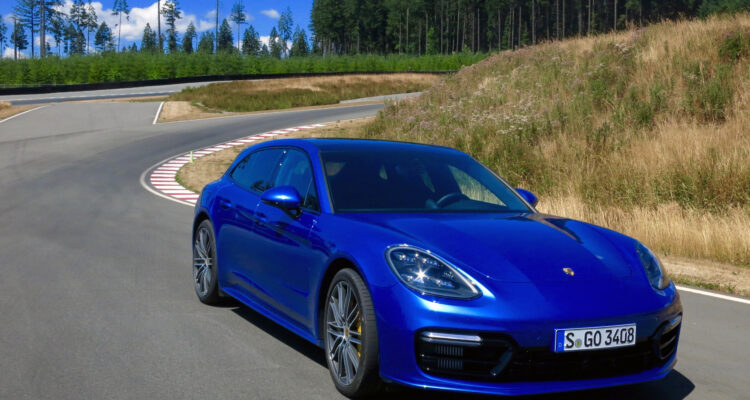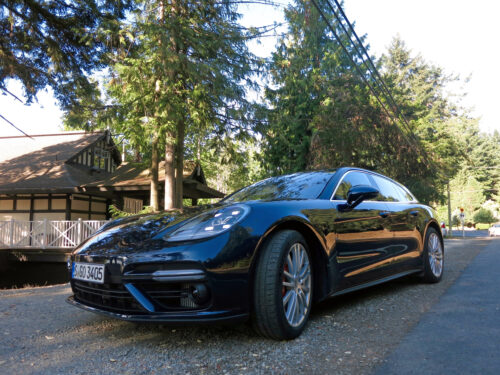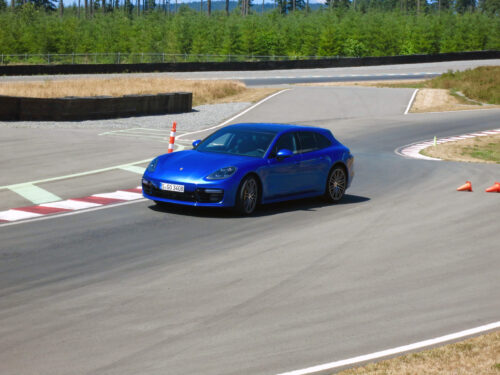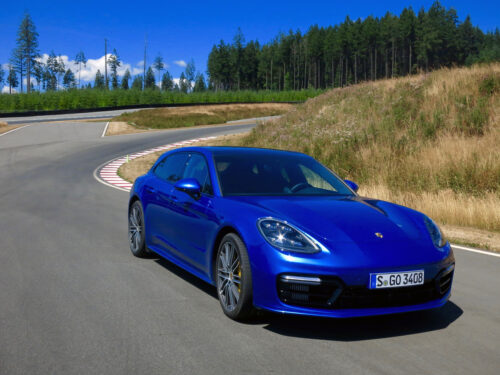Near Duncan, B.C. — Is this the one Porsche should have built first?
As capable as the Panamera is as a sedan, it’s hard not to look at the shooting-brake version and think it is more in keeping with the company’s sports-car heritage than a sedan.
In Sport Tourismo form, the Panamera exudes sportiness, with the swept-back roofline making it a car that looks fast at any speed.
While from the front, it looks just like the sedan — aside from a unique hood — from the B-pillar back, nothing is familiar. The entire body rearward of the front door is unique to the Sport Tourismo.
Inside, it’s all Panamera, featuring the new high-tech interior that includes glass control panels and touch switches with tactile feedback. They might be the easiest-to-use, least-frustrating touch switches in cars today: with the tactile feedback and need to confirm selection by adding finger pressure, you are more able to fumble blindly (because your eyes are on the road) without worrying about accidentally activating the wrong function.
In the Sport Tourismo, Porsche offers a choice of four captain’s chairs or what it calls four-plus-one seating. Four plus one is code for “you can put someone there if you really need to, but they won’t be comfortable.”
There is a fifth seat. There is a fifth seat belt. There is not much, if anything, in the way of legroom. Put it this way: if this was Victorian England, ladies would be encouraged to ride side-saddle.
Like the sedan, the Sport Tourismo offers outstanding handling that belies this car’s mass. Steering is firm, responsive and communicative. You can literally feel the front tires’ contact patches in your hands.
Rear-axle steering and electronic roll stabilization help keep the car glued in turns.
Helping the handling is a unique spoiler on the rear hatch. While we’ve seen power-operated spoilers that deploy at speed on many other Porsches, the company says this is the first one on an estate model.
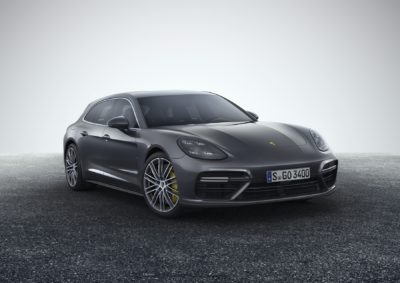
It extends from the top surface of the spoiler and can add up to 50 kilograms of downforce on the rear wheels. It is at its most aggressive position when the sunroof is open, helping counter the lift that can occur from wind entering the sunroof.
Speaking of the rear hatch, it offers a lower liftover than the sedan, making it easier to get items in and out. The floor space of the cargo area is not greatly different from the sedan’s, however the added space above adds to the cargo ability, by 50 litres.
An optional load management system includes floor rails, four tie-down points and a mesh partition. A standard cargo cover helps discourage the crowbar crowd.
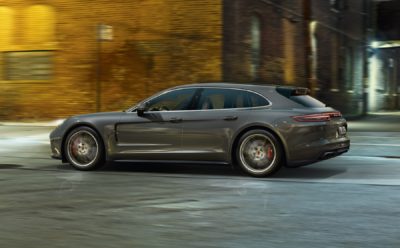
As a world car, five powertrains are offered, but don’t expect to see the diesel version in Canada. There’s a V-6 turbo, a V-6 bi-turbo, a plug-in hybrid with a V-6 turbo motor and electric motors and the performance version, a bi-turbo V-8. Power ranges from 330 horsepower to 550 horsepower.
The base motor, the V-6 turbo, is no slouch, however, with a top speed of 259 km/h and 0-100 km/h time of 5.5 seconds. The fastest of all is the V-8 bi-turbo with sport chrono package, which cuts 0-100 to 3.6 seconds. In other words, you’d be at 100 km/h before you finished reading that last sentence.
Mated to all engines is an eight-speed dual-clutch transmission Porsche calls Porsche Doppelkupplung.

While the e-Hybrid is the fuel economy winner with a combined fuel consumption of 2.5 litres per 100 km, the V-6 isn’t awful, either, at a combined 7.9 l/100 km. The V-8 bi-turbo also puts up some very non-bi-turbo, non-V-8 numbers, too, at a combined 9.5 l/100 km.
The hybrid offers one small disadvantage: it makes the car feel very heavy, which shouldn’t be surprising as it’s 155 kg heavier than the V-8 version.
With a starting price just shy of $110,000, the Panamera Sport Tourismo isn’t for everyone. But then, isn’t that the point?
2018 Panamera Sport Tourismo
Engines: 3.0-litre turbo V-6; 3.0-litre bi-turbo V-6 (4S); 4.0-litre bi-turbo V-8 (Turbo); 3.0-litre V-6 with electric (4 E-Hybrid)
Power: 330 hp @ 5,400-6,400 rpm (V-6); 440 hp @ 5,650-6,600 rpm (4S); 550 hp @ 5,750-6,000 rpm (Turbo); 462 hp @ 6,000 rpm.; (E-Hybrid)
Torque: 332 lb-ft. @ 1,340-4,900 rpm (V-6); 405 lb-ft. @ 1,750-5,500 rpm (4S); 568 lb-ft. @ 1,960-4,500 rpm (Turbo); 516 lb-ft. @ 1,100-4,500 rpm (E-Hybrid)
Brakes: six-piston aluminum monobloc calipers, cast-iron discs, front; four-piston aluminum monobloc calipers, cast-iron discs, rear
Steering: electro-mechanical power steering, optional rear-axle steering
Suspension: aluminum double-wishbone, front; aluminum multi-link with chassis subframe, rear. Adaptive air suspension with Porsche Active Suspension Management on 4S and Turbo (V-8) models.
Fuel economy (l/100 km, city/highway/combined): 10/6.7/7.9 (V-6); 10.4/6.9/8.3 (4S); 13.1/7.4/9.5 (Turbo);
Price: $109,700 (V-6); $124,500 (4S); $175,600 (Turbo); $118,600 (E-Hybrid)
Related links:
Porsche Canada



